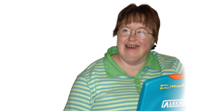|
The overall goal of this project is to identify interventions that can improve the quality of life in children with cerebral palsy (CP). In our previous NIDRR funded work we were able to identify sensitive and reliable techniques to evaluate the development of sitting postural control in typically developing infants and in infants with CP. Using these techniques, we identified a physical therapy intervention that successfully improved sitting posture in infants with CP. This foundation has strategically positioned us to now investigate the efficacy of additional innovative interventions for children with moderate to severe CP, a group of children who have been neglected in previous intervention studies. Three experiments will be used to accomplish these goals: Experiment #1 utilizes nonlinear dynamics techniques to quantify changes in postural control as measured by the Center of Pressure (COP) time series in sitting. These sensitive measures will be used to quantify postural control over time, and compare two interventions for efficacy. The first intervention focuses on principles of enhancing complexity in movement variability, and has been shown to be effective in improving infant sitting postural control in our previous research. The second intervention uses the paradigm of adding stochastic noise to the support surface to improve postural responses, a method being used successfully in adults with decreased postural control. Experiment #2 will utilize the same children as in Experiment #1, but will examine functional changes in arm use, focused attention, and play over time as sitting postural control improves. These measures will provide information on cognitive and perceptual changes that are related to changes in sitting posture, and will quantify improvements in age appropriate functional activities. Experiment # 3 will examine changes in self-care, participation, and gross motor function to determine the relationship between changes in postural control and participation within the child's environment. We hypothesize that improvements in postural control will be detected with both interventions, with greater improvement in the intervention group receiving the additional stochastic noise at the sitting surface. We further hypothesize that these improvements in postural control will coincide with changes in functional arm use and focused attention, as well as improvements in measures of participation. Taken together, these experiments will enhance our ability to provide better methods to treat children with moderate to severe CP. In addition, we will improve our understanding of the development of cognition, function, play and participation for children with CP in relation to improved postural control in sitting.
|







